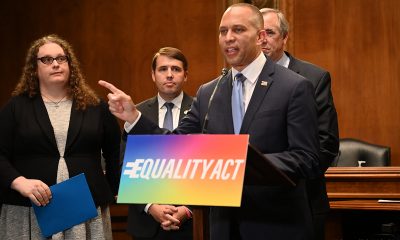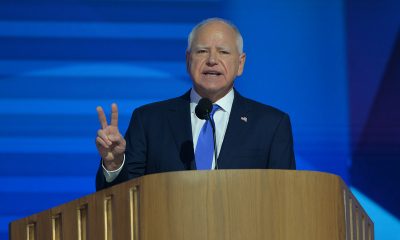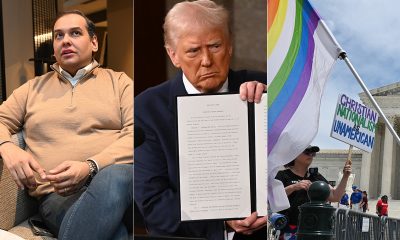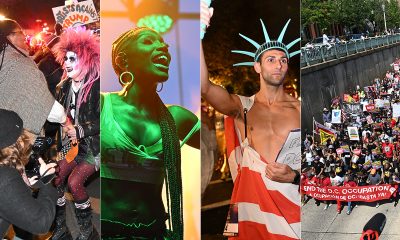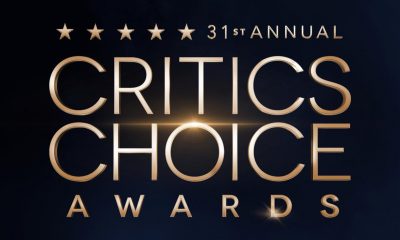Living
A dream fulfilled
MLK memorial, years in the making, resonates with LGBT community
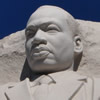
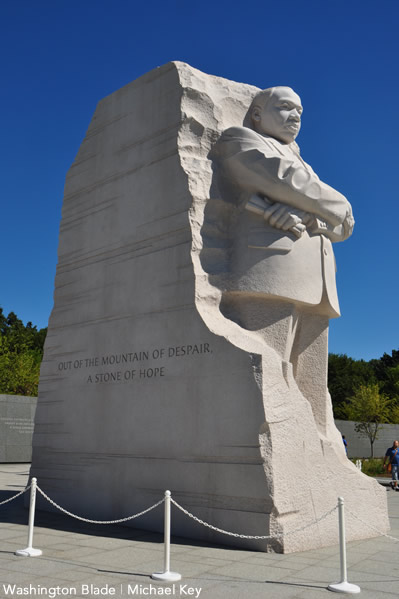
The civil rights movement pioneered by Martin Luther King, Jr., has inspired many leaders of the LGBT movement. (Washington Blade photo by Michael Key)
(UPDATE: The MLK Memorial dedication ceremony has been postponed due to Hurricane Irene. It is expected to be rescheduled for September or October.)
When a tribute to the Rev. Martin Luther King, Jr. is dedicated this weekend, it will mark more than the addition of a new monument to Washington, D.C.’s landscape.
It will symbolize the civil rights leader’s success.
The stone likeness rises as the first monument to a man of color on the National Mall, 48 years after King described his then ground-breaking dream, and in a nation where — at least ostensibly — much of that dream has been realized.
The movement was a model for countless others, including the LGBT rights push, which has shared nonviolence tenets and even leaders like gay, black activist Bayard Rustin.
Yet most similarities end there.
While fruits of the civil rights movement are evident in modern America — apparent in a widening black middle class and a black first family in the White House, for instance — the gay rights movement’s successes have been slower coming.
Same-sex marriage rights remain tenuous and limited to a handful of states; despite hate crime legislation, the threat of violence continues to deny many gays and lesbians a basic sense of safety in their hometowns.
As the nation prepares to welcome King to the National Mall, community leaders share their outlook on the LGBT movement with the Washington Blade — from a California group using civil unrest to humanize the struggle; to the partner of late gay and civil rights icon Bayard Rustin working to keep his ideals alive; to former NAACP leader Julian Bond, who uses his status as a key historic civil rights figure to promote the LGBT rights struggle as a modern civil rights fight.
They point to entrenched faith-based bigotry, and even a lack of movement cohesion, as obstacles. But each believes that by using King’s model of continued struggle, the LGBT dream of full equality can be achieved.
Images of change
The Rev. Martin Luther King, Jr. sitting in an Alabama jail cell. Firefighters battering blacks with powerful jets of water. Jeering whites pouring condiments over the heads of stoic lunch counter protesters.
They’re images that moved activist Robin McGehee, as a child growing up in Jackson, Miss.
And today as executive director of GetEqual, she organizes demonstrations to create actions and images she hopes will drive home the plight of gay and lesbian men and women just as powerfully. An absence of such visual tools encouraged McGehee to form the group, with offices in Berkeley, Calif., and Washington, D.C., in January 2010.
“We had that in reference to the AIDS movement in ACT-UP, and fighting for adequate health care. But in reference to a full civil rights fight for equality, I couldn’t think of one iconic action,” she said.
The group has orchestrated more than 40 actions in the last year, including one in which military veterans handcuffed themselves to the White House fence to protest “Don’t Ask, Don’t Tell.”
The group honed use of such actions at the Highlander Research and Education Center, a New Market, Tenn., center that trained members of the original civil rights movement. McGehee and other LGBT equality activists underwent training at the historic center in January 2010.
“Not until you can give literal imagery to that discrimination do people really resonate or get it,” McGehee said.
Yet despite mirroring the earlier movement’s successful tactics, activists’ success in mainstreaming LGBT rights remains light years behind that of racial equality — something McGehee blames on entrenched religious bigotry.
“We’ve gotten into a moment where people are using the Bible as a weapon,” said McGehee, pointing out that while religious rhetoric once justified slavery and racism, cultural changes eventually erased such thinking. “… I don’t think we’ve jumped that hurdle with regard to gays.”
McGehee is encouraged, however, by more subtle success in incorporating gays and lesbians socially. Just a few years after Ellen DeGeneres thought twice about coming out on TV, realistic portrayals of gays and lesbians are common on TV.
“In time,” she said, “I think we’re gonna get there.”
A life of service
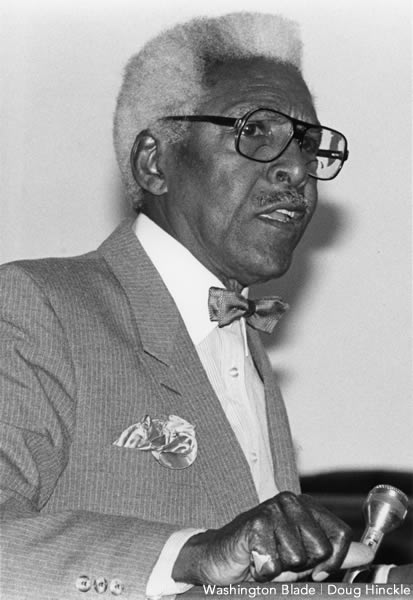
The former partner of Bayard Rustin said the gay civil rights leader would be happy with the arrival of marriage equality, but would have pushed for it in all 50 states. (Washington Blade archive photo by Doug Hinckle)
Walter Naegle had certainly heard of Bayard Rustin, the relentlessly active civil rights agitator who gained as much notoriety for his efforts to win black equality as for his open homosexuality.
But on the day he ran into the civil rights legend on a New York City corner in April 1977, he didn’t recognize him: Rustin wasn’t carrying his trademark walking stick.
“When he gave me his name, I knew,” said Naegle, whose chance meeting with Rustin lead to a 10-year relationship that ended only when the activist died in 1987.
More than two decades later, Naegle keeps Rustin’s ideals alive, working with filmmakers to promote “Brother Outsider,” a portrayal of Rustin’s story, executing his estate and generally overseeing the use of his image.
He believes Rustin’s courage, openness and tireless work — he was in his 70s and still agitating when he died — have helped make him resonate as an icon of the human rights movement.
By the time Naegle met Rustin, the activist had long been a legend. Rustin had worked with A. Philip Randolph to strengthen relationships between blacks and labor unions, but was perhaps best known for his role organizing the 1963 March on Washington.
He’d also become a gay rights icon before it was fashionable: Rustin was essentially outed in 1953 when he was arrested on a “morals charge,” yet he refused to deny the charges or his sexual orientation.
“He didn’t have to hide anything,” he said. “He was just going to be who he was and let the chips fall where they may.”
Rustin would pay the price for that openness.
“Whenever he would rise to a certain level, particularly in the African-American civil rights movement but also in other movements, something would happen and someone would try to chop him down,” Naegle said.
Nonetheless, “He was not defeated. He didn’t turn around and stop his activism — he just worked on the sidelines.”
Rustin remained active with several organizations, including the A. Philip Randolph Institute and the United States Holocaust Memorial Council, at the time of his death.
Years later, his story still has the power to inspire. Naegle said a book of his letters is slated for publication in March, in time for what would have been Rustin’s 100th birthday.
Naegle believes his partner would have been “heartened” to see marriage equality happen in even one state. But he wouldn’t have been satisfied with limited success.
“It’s fine to have these victories in urban areas,” Naegle said. “But people all over the country should be entitled to the same thing.”
“Gay and lesbian rights are not ‘special’ rights”
Julian Bond’s new fight

Former NAACP Chair Julian Bond likens the modern LGBT movement to the push for black civil rights in the ‘60s. (photo courtesy of wikimedia.org)
Where others may see conflict between the black and gay rights agendas, Julian Bond sees similarities.
Both groups struggle against bigotry based on personal characteristics. Both are entitled to basic rights by the same Constitution. And both benefit from each others’ successes.
Indeed, he argues, “People of color ought to be flattered that our movement has provided so much inspiration for others — that it has been so widely imitated,” Bond, who works as an adjunct professor at American University, told the Blade.
The man who has worn many hats as a Georgia lawmaker and leader with both the Southern Poverty Law Center and the NAACP, has more recently directed his outspoken energies to the conflict between civil rights and gay rights advocates.
It’s a particularly touchy dispute. Old school civil rights leaders and even some black gays bristle at LGBT activists’ use of King’s rhetoric to promote their agenda as a modern civil rights movement. Some site racial divisions within the LGBT movement, and argue that discrimination faced by gays isn’t as harsh as that faced by blacks.
Yet for Bond, there isn’t much of a dispute: The two groups must lock arms.
“Many gays and lesbians worked side by side with me in the ’60s civil rights movement. Am I now to tell them thanks for risking life and limb helping me win my rights, but they are excluded because of a condition of their birth?” he said. “That they cannot share now in the victories they helped to win?”
Bond has lent his outspoken rhetoric and organizational skills to many causes over the years.
While a student at Morehouse College, in Atlanta, in the ’60s, he helped organize the Student Nonviolent Coordinating Committee, he was the first president of the SPLC and was board chairman of the National Association for the Advancement of Colored People from 1998 to 2010.
He’s become one of the most vocal mainstream voices in the movement to promote equal treatment for gays and lesbians, going as far as to boycott the funeral of King widow Coretta Scott King in 2006 after the services were arranged at an anti-gay church.
In July, Bond spoke at an NAACP forum discussing gay and lesbian issues in the black community, featuring openly gay black comedian Wanda Sykes and CNN anchor Don Lemon.
“People of color carry the badge of who we are on our faces. But we are far from the only people suffering discrimination,” Bond said. “Sadly so do many others. They deserve the law’s protections and civil rights too.”
Bond’s comments stand in contrast to the black community’s historically conservative stance on gay issues.
Yet he said one need only look at the personal examples set by the lauded civil rights leaders to see whether such thinking is in line with King’s dream.
“We cannot know what Dr. King would have thought about today’s GLBT movements,” Bond said. “But if we consider the prominent role his widow, Coretta Scott King, occupied in speaking out on GLBT rights, it is hard to believe that he would not have done the same.”
Advice
How to cope when a partner gives you the silent treatment
Punishing behavior brings up memories of parent’s mistreatment

Michael,
My wife and I met less than two years ago and we were crazy about each other from the start. We wanted to spend life together so we just went for it. Maybe this wasn’t the most well-thought out decision on either of our parts but we thought that love conquers all.
But lately we’ve been arguing. The stuff we’re fighting about is never such a big deal: chores, or spending, or wanting to do different things on the weekend. But when I don’t want to go along with Michelle’s point of view, she gets angry and shuts down. Sometimes she stops talking to me for as long as a few days.
This is painful for me. My mom used to pull this stunt when I was a kid and she was mad at me. She also cut me off when I came out. We’re still estranged.
Michelle has a whole different take on this. She says I am being “mean” to her (when I don’t go along with what she wants) and this is painful, and she has to “take a break” to cool off.
I know she comes from a volatile family. She has told me there was a lot of screaming in her house, and she barely has a relationship with her parents as a result. So I get that she’s sensitive to conflict.
But I don’t think I’m being mean to her by standing up for what I want — certainly not enough to warrant her giving me the silent treatment.
We got married to have a great life together. We often do but I can’t live with someone who just shuts me out when she’s annoyed with me.
If I became a doormat and went along with everything she wants and never pushed back or complained, maybe she wouldn’t shut down. But I don’t want to do that.
I’d appreciate some ideas to improve the situation. I don’t want a divorce but I also don’t want to keep being mistreated.
Michael replies:
You can think of marriage — or any serious relationship — as a gym where you have ongoing opportunities to become an increasingly resilient person in the face of the ongoing challenges that an intimate relationship poses.
Your task here is to shift your focus toward figuring out how to handle yourself well, even in the awful circumstance of getting the silent treatment.
Michelle is not under an obligation to behave as you’d like her to. You can certainly ask her to stop withdrawing when she’s angry at you. But that doesn’t mean she is going to honor your request.
I well understand that Michelle’s punishing behavior is bringing up painful memories of your mother’s mistreatment. But if she doesn’t change her behavior, you have to find a way to live with Michelle as she is, with as much equanimity as you can muster, for as long as you choose to be married to her. If she does not change and you find her behavior to be unbearable, you can leave.
Every time she shuts down, Michelle is handing you an opportunity to figure out how you, yourself, can deal with feeling hurt and let down, rather than depending on someone else to behave as you’d like her to, or not upset you, or soothe you. Being in charge of your own mood rather than letting someone else press your buttons is a great skill to get better at.
I’m not going focus on what techniques you might use to soothe yourself — that’s a different column (or even better, a number of therapy sessions). That said, knowing that Michelle’s behavior comes from her history might help you to take it less personally. And, simply keeping in mind that living with a difficult spouse is unavoidable and worth getting better at may help you to quiet yourself down.
Another challenge that your marriage is pushing you to work on: Discerning when you can be generous, and when it is important to have a boundary. Of course, I understand that you don’t want to be a doormat by going along with whatever Michelle says and wants. But is it possible that she has a point, in that you could stand to lean more in her direction?
None of us get to have everything the way we want when we are in a relationship (much less in life). Figuring out the interplay between generosity and boundary is complicated. It often involves considering what is important to your partner; and deriving joy from her getting some of what is important to her, not only from your getting what you would like. And of course, it also involves figuring out what is most important to you.
If you set a boundary thoughtfully, because something is important to you, and Michelle doesn’t like it, you’re being handed an opportunity to get better at tolerating disappointment. Being a disappointment to your partner, and being disappointed in your partner, are both unavoidable parts of marriage: We’re all different, and at times will make choices that the other person really does not like.
If we make our decisions from a place of integrity rather than whim, entitlement, anger, or “whose turn it is”, and strive to honor the choices that our partners make from a place of integrity, this often makes the disappointment easier to bear.
Of course, it would be great if Michelle would join you in working to become a more solid and resilient spouse. As I mentioned earlier, you can’t persuade her to do so. But you can certainly tell Michelle what you are working on and ask her to consider how she, too, might use your relationship difficulties as a challenge to grow.
It isn’t easy to have such a conversation without sounding condescending. You are better positioned to do so when you are walking the walk, not just talking the talk. One good rule of thumb is to put you and your partner in the same boat, making it clear that you see the two of you as facing the same challenges, rather than positioning yourself in a superior position. Another is to initiate the conversation when you are both calm, rather than in the middle of a fight or when you’re getting the silent treatment.
One more point: If Michelle is willing, I’d suggest that you propose couples therapy as an opportunity for you two to collaborate on building a consistently loving relationship where neither of you lets your reactivity run the show.
Michael Radkowsky, Psy.D. is a licensed psychologist who works with couples and individuals in D.C. He can be found online at michaelradkowsky.com. All identifying information has been changed for reasons of confidentiality. Have a question? Send it to [email protected].

Electric-vehicle tax credits may have faded earlier this year, but EVs themselves are far from losing their spark. There are more charging stations than ever, battery ranges are longer and more realistic, and automakers have finally figured out that EVs don’t all need to look like geeky science projects or feel like failed beta tests.
Just look at these two compact electrics, which are futuristic, fun and flexible enough for work or play.
HYUNDAI IONIQ 5
$37,000 to $48,000
Range: 245 to 318 miles
0 to 60 mph: 4.5 to 7.4 seconds
Cargo space: 26.3 cu. ft.
PROS: Fast charging. Roomy cabin. Silky-smooth suspension.
CONS: Wide turning radius. Rear wiper not on all trims. Price creep.
After being introduced three years ago, what’s new for the latest Hyundai Ioniq 5? Mostly refinement. Charging is quicker, software is smarter and Hyundai continues to quietly listen to feedback, tweaking ride comfort and usability. Think of it as switching from messy eyeliner to a perfectly sharp wing.
Exterior styling remains one of this EV’s biggest conversation starters. Those pixel-inspired lights, crisp lines and slick hatchback-meets-crossover proportions exude refreshing confidence. There’s no trying to blend in, and that’s the point. Park this Hyundai anywhere and heads will turn.
On the road, the Ioniq 5 prioritizes calm over chaos. Steering is light, the suspension smooths out rough pavement and acceleration feels brisk without being aggressive. Safety tech is plentiful and well-calibrated—adaptive cruise control, lane-centering, blind-spot monitoring—all working together without seeming like a nervous backseat driver. IOW, this ride is supportive, not clingy.
Inside, the user-friendly cabin shines. The flat floor and long wheelbase create a lounge-like atmosphere, with excellent legroom and airy visibility. Seats are well-bolstered and available with eco-friendly materials, and the sliding center console adds flexibility. Cargo space is generous, and the wide windshield makes city driving stress-free. Alas, the rear wiper is only available on select models. Overall, though, I appreciated how everything looks modern without feeling cold.
What makes this Hyundai special is its vibe. An EV that embraces individuality without shouting about it.
Fun fact: The Ioniq’s ultra-fast charging can add hundreds of miles in under 20 minutes—perfect for those who hate waiting almost as much as they hate small talk on awkward first dates.
VOLKSWAGEN ID.4
$46,000 to $59,130
Range: 206 to 291 miles
0 to 60 mph: 4.4 to 7.7 seconds
Cargo space: 30.3 cu. ft.
PROS: Sure handling. Decent range. Good storage.
CONS: Body roll in curves. Fussy infotainment. No frunk.
The latest VW ID.4 focuses on polish. Software updates have fixed earlier frustrations, and overall drivability feels more cohesive. Less “learning curve” and more “hop in and go,” like a dependable bestie who doesn’t overthink things.
Styling-wise, this EV is intentionally inoffensive. Soft curves, friendly lighting and a familiar crossover shape make it approachable. While the ID.4 won’t turn heads like the Ioniq 5, that’s OK. It’s more akin to a classic outfit that always works—timeless, not trendy.
Driving the ID.4 is relaxed and predictable. This SUV prioritizes comfort over thrills, with a suspension tuned for daily commuting and long highway drives. Safety features are comprehensive and reassuring, including excellent lane assistance and collision-prevention systems. It’s the kind of car that quietly has your back, no drama required.
Inside, the ID.4 offers a calm, uncluttered cabin with good space for passengers and cargo alike. Rear-seat legroom is especially strong, making it a solid road-trip companion. The seats are plush, visibility is good and while the infotainment system isn’t the most intuitive, it’s improved enough to be more than tolerable.
The ID.4’s special sauce is balance. It doesn’t try to reinvent the wheel—it just electrifies it.
Fun fact: This is one of the most globally popular EVs, proving that sometimes being universally liked is a strength, not a personality flaw. Think, gold star gay who still surprises you.

Real Estate
Child- and pet-proofing your home for the holidays
It isn’t about being perfect but about being prepared

The holidays are meant to be joyful, cozy, and full of laughter — but if you have young children or pets, they can also feel a little chaotic. Twinkling lights, shiny decorations, guests coming and going, and tables full of tempting food can turn your home into a wonderland of curiosity and mischief. The good news? With a little thoughtful planning, you can keep the holiday magic alive while making your home safer for everyone who lives there.
There’s something oddly comforting about movies where animals go to war with holiday decorations, turning carefully strung lights and perfectly placed ornaments into chaos. Whether it’s a mischievous dog tangled in tinsel or a curious cat launching a full-scale assault on a Christmas tree, these scenes tap into a universal experience for pet owners.
The humor comes from the contrast: the human characters are trying to create warmth, tradition, and picture-perfect cheer, while the animals see the decorations as toys, obstacles, or personal enemies. The resulting destruction — trees tipping over, ornaments shattering, lights blinking out—feels exaggerated but relatable, especially during the already hectic holiday season.
Let’s start with decorations because they tend to be the biggest attraction. Ornaments sparkle, garlands dangle, and everything seems designed to be touched, pulled, or tasted. If you have little ones or pets, consider placing your most fragile ornaments higher on the tree and using shatterproof options on the lower branches. Tinsel and ribbon may look festive, but they can be dangerous if swallowed, so skipping them or keeping them well out of reach is a simple way to reduce risk without sacrificing style.
Holiday lights are another favorite fascination. Before hanging them, take a few minutes to inspect each strand for frayed wires or broken bulbs. Secure cords along walls or behind furniture so they’re harder to grab or chew and unplug them when you leave the house or head to bed. Not only does this help prevent accidents, but it also gives you one less thing to worry about during a busy season.
The Christmas tree itself can become a focal point for exploration. Make sure it’s sturdy and well-anchored so it doesn’t tip if a toddler tugs on a branch or a pet decides to investigate. If you use a real tree, cover the water base since tree water can contain additives that aren’t safe if consumed. For artificial trees, keep an eye out for loose pieces or needles that could become choking hazards.
Food is a big part of holiday celebrations, and it’s also one of the most common sources of trouble. Many traditional treats—like chocolate, grapes, raisins, alcohol, and foods containing xylitol—are dangerous for pets. Keep plates and serving dishes up high, secure the trash can, and gently remind guests not to slip pets or kids “just a little bite” without checking first. For children, be mindful of hard candies, nuts, and small treats that could pose choking risks.
Candles and fireplaces add warmth and charm, but they deserve extra caution. Flameless candles are a wonderful alternative if you want ambiance without worry. If you do use real candles, place them well out of reach and never leave them unattended. Fireplaces should always have a sturdy screen or gate, especially with crawling babies or curious pets nearby.
Holiday gatherings bring wonderful energy into your home, but they can also create new challenges. Doors opening frequently make it easier for pets to slip outside, so consider setting up a quiet, comfortable space where they can relax during busy get-togethers. This can help reduce stress for them and give you peace of mind. For children, stair gates, locked cabinets, and clear boundaries can help prevent accidents when there’s extra excitement in the air.
New toys and gifts are another thing to watch closely. Packaging, twist ties, plastic wrap, and especially button batteries should be cleaned up promptly. These items are easy to overlook in the excitement of gift-opening but can be dangerous if swallowed. Taking a few minutes to tidy up as you go can make a big difference.
Lastly, try to keep routines as steady as possible. The holidays naturally disrupt schedules, but familiar mealtimes, naps, walks, and bedtime rituals help children and pets feel secure. A calmer household often means fewer accidents and a happier experience for everyone.
At the end of the day, child- and pet-proofing your home for the holidays isn’t about being perfect but about being prepared. A few small adjustments can help you relax, enjoy your guests, and focus on what truly matters: creating warm, happy memories with the ones you love. When your home feels safe, the holidays feel even sweeter.
Valerie M. Blake is a licensed Associate Broker in D.C., Maryland, and Virginia with RLAH @properties. Call or text her at 202-246-8602, email her at [email protected] or follow her on Facebook at TheRealst8ofAffairs.
-

 Photos4 days ago
Photos4 days agoThe year in photos
-

 Sponsored3 days ago
Sponsored3 days agoSafer Ways to Pay for Online Performances and Queer Events
-

 District of Columbia2 days ago
District of Columbia2 days agoTwo pioneering gay journalists to speak at Thursday event
-

 a&e features2 days ago
a&e features2 days agoQueer highlights of the 2026 Critics Choice Awards: Aunt Gladys, that ‘Heated Rivalry’ shoutout and more

